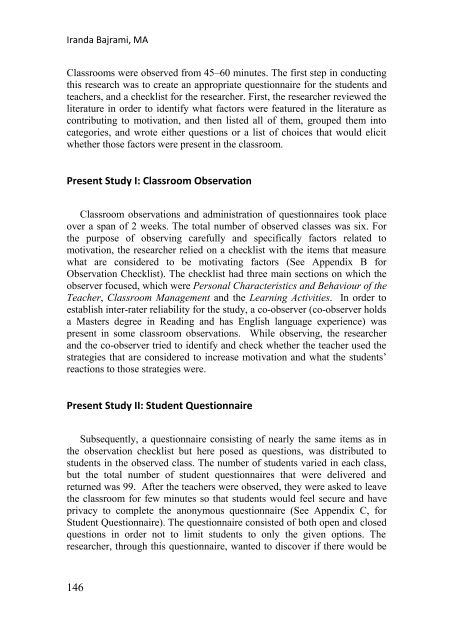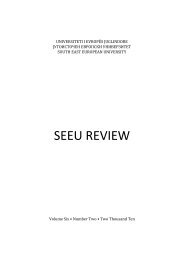SEEU Review vol. 5 Nr. 2 (pdf) - South East European University
SEEU Review vol. 5 Nr. 2 (pdf) - South East European University
SEEU Review vol. 5 Nr. 2 (pdf) - South East European University
Create successful ePaper yourself
Turn your PDF publications into a flip-book with our unique Google optimized e-Paper software.
Iranda Bajrami, MA<br />
Classrooms were observed from 45–60 minutes. The first step in conducting<br />
this research was to create an appropriate questionnaire for the students and<br />
teachers, and a checklist for the researcher. First, the researcher reviewed the<br />
literature in order to identify what factors were featured in the literature as<br />
contributing to motivation, and then listed all of them, grouped them into<br />
categories, and wrote either questions or a list of choices that would elicit<br />
whether those factors were present in the classroom.<br />
Present Study I: Classroom Observation<br />
Classroom observations and administration of questionnaires took place<br />
over a span of 2 weeks. The total number of observed classes was six. For<br />
the purpose of observing carefully and specifically factors related to<br />
motivation, the researcher relied on a checklist with the items that measure<br />
what are considered to be motivating factors (See Appendix B for<br />
Observation Checklist). The checklist had three main sections on which the<br />
observer focused, which were Personal Characteristics and Behaviour of the<br />
Teacher, Classroom Management and the Learning Activities. In order to<br />
establish inter-rater reliability for the study, a co-observer (co-observer holds<br />
a Masters degree in Reading and has English language experience) was<br />
present in some classroom observations. While observing, the researcher<br />
and the co-observer tried to identify and check whether the teacher used the<br />
strategies that are considered to increase motivation and what the students’<br />
reactions to those strategies were.<br />
Present Study II: Student Questionnaire<br />
Subsequently, a questionnaire consisting of nearly the same items as in<br />
the observation checklist but here posed as questions, was distributed to<br />
students in the observed class. The number of students varied in each class,<br />
but the total number of student questionnaires that were delivered and<br />
returned was 99. After the teachers were observed, they were asked to leave<br />
the classroom for few minutes so that students would feel secure and have<br />
privacy to complete the anonymous questionnaire (See Appendix C, for<br />
Student Questionnaire). The questionnaire consisted of both open and closed<br />
questions in order not to limit students to only the given options. The<br />
researcher, through this questionnaire, wanted to discover if there would be<br />
146

















